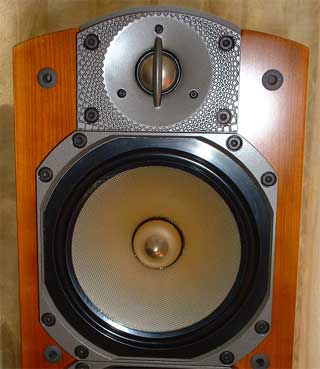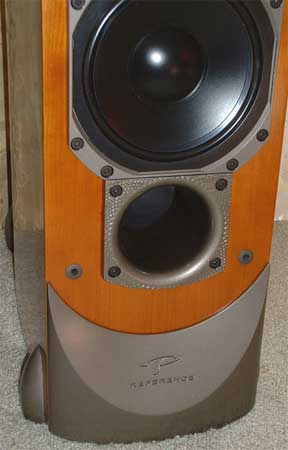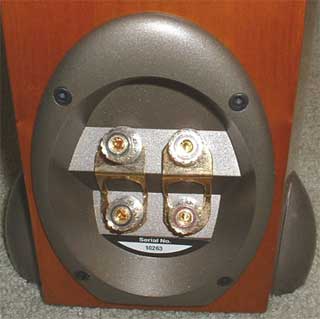|
||||||||||
|
Introduction The story of success of Paradigm can be attributed to the high performance vs. cost ratio that the company delivers to its products. In fact, Paradigm is the brand that is suggested by people almost constantly in various on-line audio forums when someone asks an opinion about budget speakers to listen to. To me personally, Paradigm was the brand that started it all, my first introduction into the hi-fi world many many years ago. I began in this hobby like many people do, with a pair of budget speakers and modest electronics, and I was lucky to have the Paradigm Minis as my first hi-fi speakers (of course I had owned several other speakers before that, but none could be considered hi-fi, at least by my current personal standard). Not only was I a happy owner of those little speakers, but I learned a very valuable lesson, which some people who are into this hobby sometimes forget: you don't need to spend a good fortune to have high quality sound. My system has evolved significantly since then, and I have not reviewed Paradigm speakers for Secrets until now, but every time I hear the Paradigm name mentioned, fond memories of my first hi-fi endeavor always linger. Paradigm has evolved significantly too, from a company that focused only on budget-minded consumers into a company that offers a wide range of products, to cater not only the budget-minded but also the consumers for whom cost is no object (or almost no object). The Reference Signature
series marks Paradigm's venture to satisfy the latter group. But even though
this series is the highest level in the Paradigm line, the prices of the
products from that series are not as stratospheric as prices of some
speakers from some other high-end brands. I guess Paradigm still aims at
offering product with a high value, which is what the company has been
known for. If I'm right, surely this is good news for the die-hard enthusiasts. The S8 speakers reviewed here is the current top of the line
in the Paradigm Reference Signature series. Upon unpacking the two big
boxes that were used to ship these 200 pounds-per-pair speakers, I was
immediately impressed by the solid construction and the beautiful cherry
finish of their cabinets. The distinctive curvy side and top baffles of the
cabinet, as well as the titanium-gray elements (die-cast aluminum) on top, front
bottom, and footings, add more to the elegance of the speakers. The two different port sizes are used to further refine the tuning of the port. The array of drivers that Paradigm employed on the S8 (and other members of the Signature series) are of very high quality and look quite impressive. At a glance, the driver configurations of the speakers in the
Signature series look similar to the ones in the Studio series, which are
lower in price, but actually there are quite a number of differences. For
example, the tweeter in the Signature line uses dual super neodymium
magnets for greater power handling instead of ferrite as in the Studio
line. The magnet structures are more refined in the drivers of the
Signature series to allow for better transient and phase response along
with output and linearity. Also, the Signature series use a higher grade of
components in their crossovers than the Studios. According to
Paradigm, all these improvements help in achieving a higher level of
performance in the Signature series. For the evaluation, I followed Paradigm's recommendation (as
given in the user's manual) of separating the speakers at about
three-quarters of the distance of each speaker from the listening position
(12 ft) and toed them in a little bit. Moving speakers of such weight and
size was not an easy endeavor, but fortunately, I found the location where
I thought the speakers sounded best after only very few iterations. When I began my critical listening after breaking-in the S8
speakers for many hours, I was immediately taken by how sweet and natural
the midrange presentation was. Singers' voices, string
instruments, piano, and even singers' breath were all presented with
amazing presence and realism. This very aspect is what often
differentiates good and great speakers. And for sure, the S8 speakers
belong to the great category in terms of their midrange performance. A little word of caution in regards to placement
follows. Paradigm recommends placing the speakers at least 8" from the
wall behind them. In my room, following that recommendation with distance
of the speakers to the wall behind them closer than about 1.5 ft, I found
the bass of the S8 a bit too bloomy for my taste, which blurred the bass
definition somewhat. Only after I pulled the speakers into the room at
about 2 ft from the wall that I felt satisfied with their bass response.
Your room and taste of course, will determine your end setup, but make
sure you spend time with this placement aspect to optimize your results.
The bass presentation from the S8 should be enough for most CDs, but the
ones containing the lowest octave, such as in pipe organ, might need a
subwoofer. The S8's also had excellent transparency.
The ability of the S8 to just disappear from the musical soundstage and to
just let the music through was one of the strengths of the speakers. No
wonder that in its Signature series product catalog, Paradigm uses this
line: “A higher level of transparency,” which I found to be quite
appropriate. The Signature series marked Paradigm's entrance into the
extreme of the high-end world, where cost is often no object. Although
this entrance was made only recently, but with many years of experience in
designing and manufacturing speakers in its back pocket, Paradigm seems to
make this entrance in sure step and glorious fashion. The elegant-looking
Signature S8 speakers reviewed here are very impressive in every aspect of
their performance. Certainly their price tag of $5400 (or $6000 for glossy
black and Bird's Eye maple finishes) cannot be considered cheap, but I can
tell you without hesitation that you get your money's worth with these
speakers. In fact, when you consider that many speakers in the high-end
world carry stratospheric price tags, which can be many times higher than
the S8 price, then the word “value” is written all over the S8 speakers.
And value seems to be the tradition that attaches to the Paradigm name,
and I'm glad to report that this tradition carries even to its top of the
line product. Highly recommended!
Associated Equipment for This Review:
|
||||||||||


 The
S8 tower is a six-driver, three-way ported design. At the top of the driver array is
a 1" gold-anodized aluminum dome tweeter with integrated die-cast heat-sink.
Underneath the tweeter is a 7" mica-loaded-polymer midrange driver with
gold-anodized solid-aluminum phase plug. This driver uses 1-1/2" voice
coil, super neodymium ring magnet, and is ferro-fluid damped/cooled in a
die-cast heat-sink chassis.
The
S8 tower is a six-driver, three-way ported design. At the top of the driver array is
a 1" gold-anodized aluminum dome tweeter with integrated die-cast heat-sink.
Underneath the tweeter is a 7" mica-loaded-polymer midrange driver with
gold-anodized solid-aluminum phase plug. This driver uses 1-1/2" voice
coil, super neodymium ring magnet, and is ferro-fluid damped/cooled in a
die-cast heat-sink chassis.
 During
most of the evaluation, the S8 speakers were driven by my trusty Classé
CA-100 amplifier. Even though this amplifier only puts out 100 W per
channel, it proved to be sufficient for the speakers. Definitely the
amplifier could drive the speakers to higher-than-I-can-bear
sound-pressure-levels (SPLs). The S8 might be big and imposing, but they
were relatively easy to drive. I did not try bi-wiring or bi-amping during
this review.
During
most of the evaluation, the S8 speakers were driven by my trusty Classé
CA-100 amplifier. Even though this amplifier only puts out 100 W per
channel, it proved to be sufficient for the speakers. Definitely the
amplifier could drive the speakers to higher-than-I-can-bear
sound-pressure-levels (SPLs). The S8 might be big and imposing, but they
were relatively easy to drive. I did not try bi-wiring or bi-amping during
this review.  In
terms of imaging, the presentation of the S8 speakers was neutral, neither
forward nor laid-back. For most recordings, the lead singer' vocal was
located at the plane of the speakers. The S8's imaged steadily, and
with good recordings, they were capable of depicting a nice three-dimensional
soundstage. A good acoustic jazz recording such as Charles Christopher by
Phil Woods from Chesky's 10th Anniversary Special Edition Jazz Celebration
really exemplified these characteristics. Each instrument had its specific
location on the soundstage, and the separation between the instruments
playing as well as the depth layering was easily identifiable. This is
again the sign of great speakers.
In
terms of imaging, the presentation of the S8 speakers was neutral, neither
forward nor laid-back. For most recordings, the lead singer' vocal was
located at the plane of the speakers. The S8's imaged steadily, and
with good recordings, they were capable of depicting a nice three-dimensional
soundstage. A good acoustic jazz recording such as Charles Christopher by
Phil Woods from Chesky's 10th Anniversary Special Edition Jazz Celebration
really exemplified these characteristics. Each instrument had its specific
location on the soundstage, and the separation between the instruments
playing as well as the depth layering was easily identifiable. This is
again the sign of great speakers.

